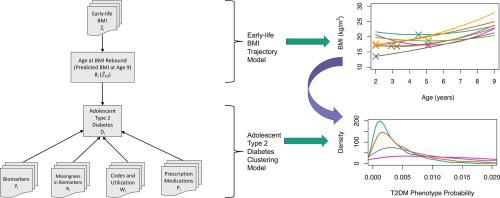Journal of Biomedical informatics ( IF 4.0 ) Pub Date : 2020-12-11 , DOI: 10.1016/j.jbi.2020.103654 Rebecca A Hubbard 1 , Jinyu Xu 2 , Robert Siegel 3 , Yong Chen 1 , Ihuoma Eneli 2

|
Use of routinely collected data from electronic health records (EHR) can expedite longitudinal studies that investigate childhood exposures and rare pediatric health outcomes. For instance, characteristics of the body mass index (BMI) trajectory early in life may be associated with subsequent development of type 2 diabetes. Past studies investigating these relationships have used longitudinal cohort data collected over the course of many years to investigate the connection between BMI trajectory and subsequent development of diabetes. In contrast, EHR data from routine clinical care can provide longitudinal information on early-life BMI trajectories as well as subsequent health outcomes without requiring any additional data collection. In this study, we introduce a Bayesian joint phenotyping and BMI trajectory model to address data quality challenges in an EHR-based study of early-life BMI and type 2 diabetes in adolescence. We compared this joint modeling approach to traditional approaches using a computable phenotype for type 2 diabetes or separately estimated BMI trajectories and type 2 diabetes phenotypes. In a sample of 49,062 children derived from the PEDSnet consortium of pediatric healthcare systems, a median 8 (interquartile range [IQR] 5–13) BMI measurements were available to characterize the early-life BMI trajectory. The joint modeling and computable phenotype approaches found that age at adiposity rebound between 5 and 9 years was associated with higher odds of type 2 diabetes in adolescence compared to age at adiposity rebound between 2 and 5 years (joint model odds ratio [OR] = 1.77; computable phenotype OR = 1.88) and that BMI in excess of 140% of the 95th percentile for age and sex at age 9 years was associated with higher odds of type 2 diabetes in adolescence relative to children with BMI from 100 to 120% of the 95th percentile (joint model OR = 6.22; computable phenotype OR = 13.25). Estimates from the separate phenotyping and trajectory model were substantially attenuated towards the null. These results demonstrate that EHR data coupled with modern methodologic approaches can improve efficiency and timeliness of studies of childhood exposures and rare health outcomes.
中文翻译:

使用贝叶斯聚类和轨迹分析通过电子健康记录研究小儿健康结局
使用从电子健康记录(EHR)中定期收集的数据可以加快纵向研究的速度,这些研究调查了儿童时期的暴露情况和罕见的儿科健康状况。例如,生命早期的体重指数(BMI)轨迹特征可能与2型糖尿病的后续发展有关。过去研究这些关系的研究使用了多年以来收集的纵向队列数据,以研究BMI轨迹与糖尿病后续发展之间的联系。相反,常规临床护理的EHR数据可以提供有关早期BMI轨迹以及后续健康结果的纵向信息,而无需任何其他数据收集。在这个研究中,在基于EHR的青春期早期BMI和2型糖尿病研究中,我们引入了贝叶斯联合表型和BMI轨迹模型来应对数据质量挑战。我们将这种联合建模方法与使用2型糖尿病的可计算表型或单独估计的BMI轨迹和2型糖尿病表型的传统方法进行了比较。在来自儿科医疗系统PEDSnet联盟的49,062名儿童的样本中,中位数为8(四分位间距[IQR] 5-13)BMI测量值可用来表征早期BMI轨迹。联合建模和可计算表型方法发现,与2-5岁之间的肥胖反弹年龄相比,5岁至9岁之间的肥胖反弹年龄与2型糖尿病的高几率相关(联合模型优势比[OR] = 1.77 ;可计算的表型OR = 1.88),且相对于BMI患儿,BMI患儿在9岁时的年龄和性别超过95%百分位的140%与2型糖尿病的青春期几率较高。第95个百分点(联合模型OR = 6.22;可计算表型OR = 13.25)。来自单独的表型和轨迹模型的估计被大大减弱为零。











































 京公网安备 11010802027423号
京公网安备 11010802027423号